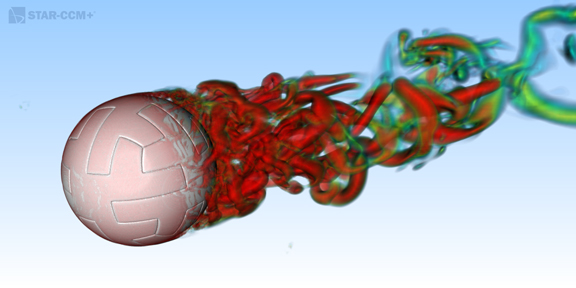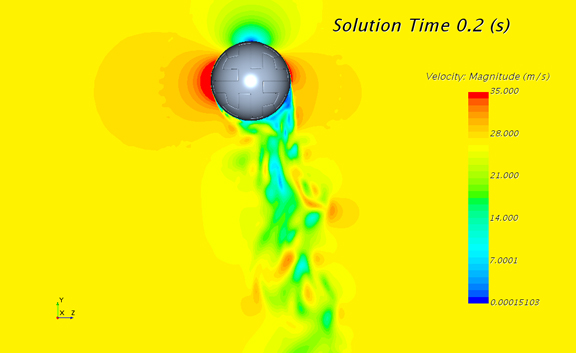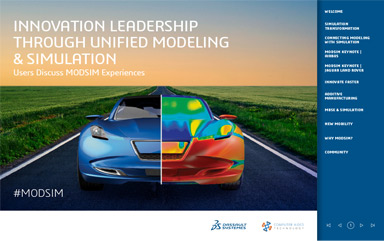
Siemens PLM’s Shankara uses STAR-CCM to simulate Cristiano Rohaldo’s free kick against Spain in the World Cup Russia 2018. Image courtesy of Shankara.
July 5, 2018
On June 15, in the 2018 FIFA World Cup Russia's Group B matches, Spain appeared destined for victory with one goal in the lead against Portugal. But that all changed when a foul on Spain's side gave Portugal's Cristiano Ronaldo a free kick. Known both for his good looks and his superb footwork, Ronaldo scored, forcing a draw on Spain's otherwise assured victory.
Watching this moment on TV, Prashanth Shankara, Siemens PLM Software's marketing manager and engineer, decided to kick off a CFD simulation to recreate the memorable time slice.
Most soccer fans tend to focus on the kick and the star athlete, but Shankara shifted his attention to the ball itself.
“People don't realize how the equipment can affect the outcome of a game,” he noted. “In my view, the same kick executed on a different ball would have had different results.”
The aerodynamics of the Adidas Telstar 18 (the official ball for 2018 FIFA World Cup Russia) was just as important as Ronaldo's kick. It was the combination of the two that created the elegant curve the ball took to evade the wall of Spanish defenders and flew into undefended upper corner of the goal, Shankara assessed.
Setting Up the Ronaldo Kick
Preparing to mimic Ronaldo's kick in CFD means getting certain facts about the event as a set of computable values. So Shankara went to work, digging into scientific literature, weather forecasts, published articles and video footage.
“I knew a fair bit about the ball itself. The specifications of the Adidas Telstar 18 have been published by Adidas,” he said. “And Prof. John Eric Geoff from Lynchburg College has done surface measurements of the ball and published a paper.”
Prof. Geoff collaborated with the University of Tsukuba, Japan, to measure the seams that join the panels of each ball and record its physical properties.
“Information about the actual kick itself came from TV footage,” said Shankara. He watched about 15-20 videos before stumbling on the ones that mentioned the actual speed at which the ball traveled, calculated from HD footage of the event. It's said to be around 60mph, Shankara recalled.
The time of ball travel was easily measured from the footage of the kick itself. It was around 0.82 second, Shankara decided. This became the length of time to be simulated in CFD.
“The most crucial data is the spin on the ball. Unfortunately I couldn't find any data on it,” said Shankara. “But generally it's within 5-10 revolutions per second, based on how close the player is to the goal, so I chose to approximate it as 5 revolutions per second.”
 CFD analysis of the aerodynamics of Cristian Ronaldo's free kick against Spain. Image courtesy Prashanth Shankara, Siemens PLM.
CFD analysis of the aerodynamics of Cristian Ronaldo's free kick against Spain. Image courtesy Prashanth Shankara, Siemens PLM.What he couldn't model was the roughness of the ball's surface, which affects the aerodynamics. “Different balls have different surface roughness, which is difficult to model in CFD,” said Shankara. “That's another factor of assumption.”
The ball's geometry was available from a public 3D model source. “If I had access to laser-scanned geometry, that would have been more accurate,” said Shankara.
Shankara also had data from a wind tunnel test done at ground condition—that is, with the ball not spinning. “So I first simulated the non-spinning ball, validated my findings against the wind tunnel test results, then proceeded to simulate the ball with spins,” he explained.
24 Hours to Simulate 0.82 Seconds
Shankara ran the Ronaldo kick simulation on a cluster with 96 CPU cores—one that he happened to have access to. He split the ball and the surrounding area into 30 million hexahedral cells and solved the scene using Navier-Stokes equations, he explained in his blog.
It took him about 24 hours to complete the simulation. That, he pointed out, was one reason he chose not to simulate the ball's travel path.
“To model the ball's path of travel, I would have to simulate every position of the ball as it moves along the path,” he explained. “That would take a lot more computing power and time. Based on my experience, to calculate the time steps accurately, it would have taken about three days.”
In an imaginary scenario where Ronaldo would help him with experiments, would he put sensors on Ronaldo to capture the characteristics of the kick?
“From CFD point of view, what's crucial is what happens after the kick. So the speed with which the ball travels, the angle, the spin—these are the inputs we need,” Shankara said. “But I'd be curious to find out what happens if Ronaldo executes the same free kick on various different balls.”
Adidas began supplying the official balls for the World Cup beginning in 1970 when the game took place in Mexico, according to the site World Cup Balls. Every tiny improvement made to the ball's design has an impact on its aerodynamics.
“Even if aerodynamically the Telstar 18 isn’t that different from the [2014 World Cup's] Brazuca, it’s still going to wobble a little bit differently because the panel shapes are different,” Prof. Goff said. (”How the new World Cup ball was designed not to influence the game,” Popular Science, June 18, 2018)
For more, read Shankara's original blog post on LinkedIn here.
More Siemens Digital Industries Software Coverage
Subscribe to our FREE magazine, FREE email newsletters or both!
About the Author
Kenneth Wong is Digital Engineering’s resident blogger and senior editor. Email him at [email protected] or share your thoughts on this article at digitaleng.news/facebook.
Follow DE




